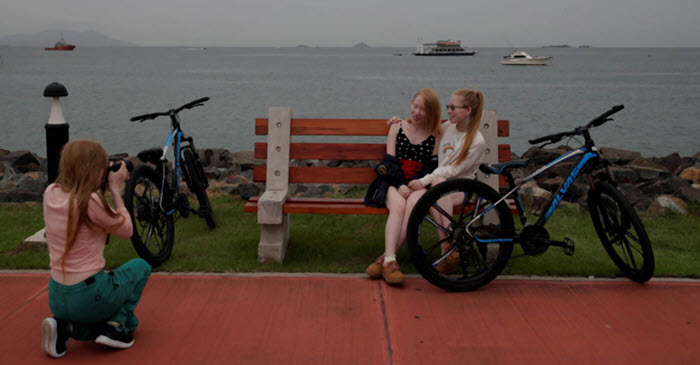Yaili, Aydili and Ceily walked down the street huddled under a single umbrella, having forgotten their other one at home. Although they are covered from the neck down and have applied plenty of sunscreen, the strength of the sun’s UV radiation was intense in Panama and penetrated the fabric of their clothing. The three girls are known affectionately as the “blonde sisters” in their neighbourhood, inhabited mainly by members of the Guna indigenous group.
Yaili and Aydili are twins, and all three are living with albinism.
“Our mother was born very white and they thought she was an albino, but later, she gradually became darker. Our great grandfather always told her she was going to have white children. Somehow, he had that presentiment,” said 18-year-old Ceily, the youngest of the three.
They are not the only members of their family with this hereditary condition, which is characterised by the partial or complete absence of pigment in the skin, hair and eyes. They also have a cousin and uncle living with albinism.
“We normally don’t go out on the street at this time. We wait for the sun to go down,” one of the twins said.
Their case may appear to be a genetic anomaly, but in fact, their condition is quite common among members of this indigenous group. Experts say the rate of people living with albinism within the Guna population is among the highest in the world, with roughly one in 150 people having the condition. By way of comparison, the rates in the United States and Mali (a West African nation where the condition is particularly prevalent) are one in 18,000 people and one in 1,000, respectively.
French anthropologist Pascale Jeambrun has been studying this genetic condition for decades and says its prevalence among the Guna is particularly notable. “The albino gene has been present in the Americas since the Bering migration (when the hemisphere was populated) and there are 10 [indigenous] groups that have it, but in none of the others is it as strong as in this one,” she said.
Endogamy and geographical isolation are the main explanations. The Guna, one of Panama’s seven indigenous groups, have a population of 60,000 (one in seven of whom are carriers of the gene) and are natives of an archipelago of small islands in the Caribbean waters off Panama. Many of the islets are more than five hours by boat from the coast and even the most heavily populated have no more than 1,000 inhabitants.
Although half of the population lives in Panama City, they continue to marry other Guna from their home islands.
The type of albinism characteristic of the Guna (OCA 2) is the not the most serious of all types because their bodies start producing a pigment called melanin as they get older, but people with this condition, especially those in tropical countries, still must exercise caution throughout their lives to avoid skin cancer. Besides skin lesions, people living with albinism suffer from various eye problems such as nystagmus (rapid involuntary eye movement), strabismus (crossed or turned eye), photophobia (light sensitivity) and myopia (nearsightedness) and must regularly have their vision checked.
“My husband and I decided not to have more children because we can’t risk having another albino,” said Yamilca Guerrero, head of the SOS Albinos Panama Foundation, which distributes sunscreen on the archipelago to people with this condition. “It’s too expensive to care for them and we can’t afford it.”
!['When two gene-carrying parents get together, there's a 25 percent chance that the child will be albino, a 50 percent chance that he or she will be a gene carrier and a 25 percent chance that he or she will be healthy,' said french anthropologist Pascale Jeambrun, who has been studying this genetic condition for decades. [Bienvenido Velasco/EPA]](https://www.aljazeera.com/mritems/Images/2019/7/30/709fe3df764546b9a411c2a3035fbd05_8.jpg)

![Two children play during a family gathering in the Panama Oeste province. [Bienvenido Velasco/EPA]](https://www.aljazeera.com/mritems/Images/2019/7/30/273eb2b1c4624e8a98348453f1981682_8.jpg)
![Five-year-old Loidibeth Alfaro, front-left, shelters from the rain at a school on the Gardi Sugdub island, in the Guna Yala region. Experts say the rate of people living with albinism within the Guna population is among the highest in the world. [Bienvenido Velasco/EPA]](https://www.aljazeera.com/mritems/Images/2019/7/30/58b4d3dc7722413e852176e8bce82c15_8.jpg)
![Yamaris Lopez, right, 11, attends class at a school on the Gardi Sugdub island. Besides skin lesions, people living with albinism suffer from various eye problems. [Bienvenido Velasco/EPA]](https://www.aljazeera.com/mritems/Images/2019/7/30/de166ecff29a46c5a6cddbeefeda5002_8.jpg)
![Five-year-old Loidibeth Alfaro attends class at a school on the Gardi Sugdub island. [Bienvenido Velasco/EPA]](https://www.aljazeera.com/mritems/Images/2019/7/30/ee49bb3f39fc419cb7f381f9076b0229_8.jpg)
![Yamaris Lopez, 11, and five-year-old Loidibeth Alfaro attend school on the Gardi Sugdub island. [Bienvenido Velasco/EPA]](https://www.aljazeera.com/mritems/Images/2019/7/30/3467a7111f6a4ef0bb929159fa5b14eb_8.jpg)
![Aydili Gonzalez, right, 23, teaches her sister Ceily, left, 18, how to ride a bike. [Bienvenido Velasco/EPA]](https://www.aljazeera.com/mritems/Images/2019/7/30/5f1982abe33041a6a011082c33d64f39_8.jpg)
![Six-year-old Brenda Hawkins shows a frame for photos she made at school. The condition is characterised by the partial or complete absence of pigment in the skin, hair and eyes. [Bienvenido Velasco/EPA]](https://www.aljazeera.com/mritems/Images/2019/7/30/172f8d3dd24e4fdd976398a4a76dc062_8.jpg)
![Graphic designer Armando Silos, 55, shows a picture of him and his friend who is also living with albinism. [Bienvenido Velasco/EPA]](https://www.aljazeera.com/mritems/Images/2019/7/30/40f3d30fe83940d58f580302b520c204_8.jpg)
![Six-year-old Brenda Hawkins plays with her albino doll at her home in the Panama Oeste province. [Bienvenido Velasco/EPA]](https://www.aljazeera.com/mritems/Images/2019/7/30/3789a3331f4a455487b570c2d1dd478a_8.jpg)
![Ceily Gonzalez, 18, poses for a photo at the Causeway Islands in Panama City. Together with her twin sisters, they are known affectionately as the 'blonde sisters' in their neighbourhood, inhabited mainly by members of the Guna indigenous group. [Bienvenido Velasco/EPA]](https://www.aljazeera.com/mritems/Images/2019/7/30/1feba259261046e789f24bf8d4ec409d_8.jpg)